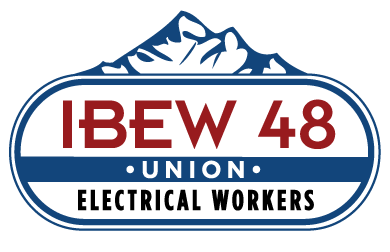Labor's Day
Sep 01, 2021 - by: outlier-admin

Many Americans know Labor Day only as a symbolic end to summer. The last long weekend to get out of town, or fire up the barbeque for friends and family before preparation for fall and the winter months to come. Others look forward to Labor Day weekend for the start of their beloved football season. Before I joined the IBEW and began to study labor history, I didn’t think of Labor Day as much more than this, myself. Of course, the origin and meaning of this distinctly American* day are much more important to the American labor movement than a simple holiday at the end of summer.
The origin of Labor Day can be traced to 1882, when at a meeting of the Central Labor Union of New York, wanting to recognize the struggles of labor, and to celebrate its achievements, it was proposed that “a day should be set aside as a festive day [for] a parade through the streets of the city.” It was further proposed that it should be on the first Monday in September, since “it would come at the most pleasant season of the year, midway between the Fourth of July and Thanksgiving, and would fill a wide gap in the chronology of legal holidays.” There is some discrepancy over whether this proposal came from Peter J. McGuire, general secretary of the Brotherhood of Carpenters and Joiners and a co-founder of the American Federation of Labor, or Matthew Maguire, a machinist and secretary of the Central Labor Union of New York in 1882. What is undisputed is that the proposal was enthusiastically received and September 5, 1882 was set as the date for its first parade.
On the morning of September 5, 1882, large amounts of workers turned out to watch the parade, but few had showed up to march. That, combined with a heavy police presence due to concern of rioting, almost spelled disaster for that first Labor Day. At 10am, when the parade was set to start, the few who came out to march were assembled, but had no band to lead the march. Just then, 200 members of the Jewelers Union of Newark Two turned onto lower Broadway – and they had a band! As the Jewelers marched by, those assembled fell in behind them, as did many of the spectators. The final reports total the number of marchers between 10,000 and 20,000 men and women. At Noon, the parade met its end at Reservoir Park, where nearly 25,000 union members and their families remained and celebrated Labor’s first Day well into the night.
On September 5, 1883, labor turned out again for the second annual march through New York City. In 1884, at the convention of the Federation of Organized Trades and Labor Unions (precursor of the AFofL), the following resolution was unanimously adopted: “Resolved, That the first Monday in September of each year be set apart as labor’s national holiday, and that we recommend its observance by all wage workers, irrespective of sex, calling, or nationality.” That year workers marched in Buffalo, Cincinnati, Lynn and Haverhill Massachusetts (then centers of the textile industry), and New York City. Momentum for the holiday continued to grow and in 1887, Oregon became the first state in the Union to make Labor Day official. In 1894, legislation was introduced in Congress to establish Labor Day, the first Monday in September, as a national legal holiday. Under tremendous pressure to repair national labor relations after the disastrous Pullman Strike, the bill was adopted by Congress on June 28, 1894 and signed the same day by President Cleveland.
*Canada’s labor movement, being tied to its American counterpart, celebrates Labour Day on the first Monday in September.


